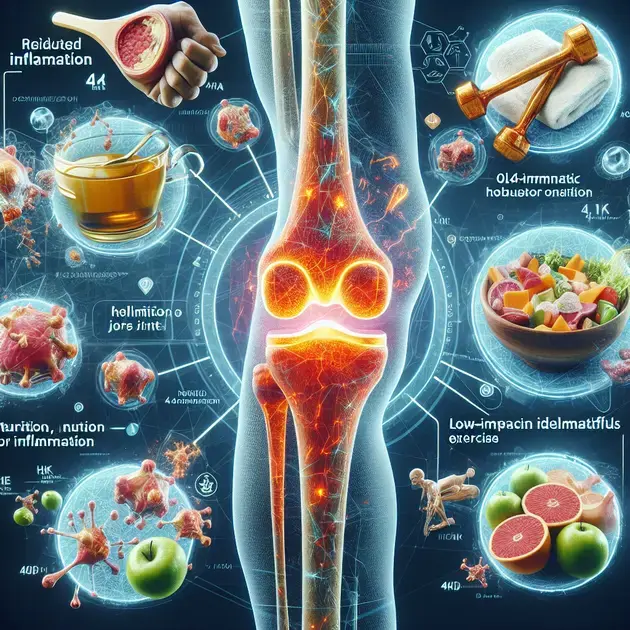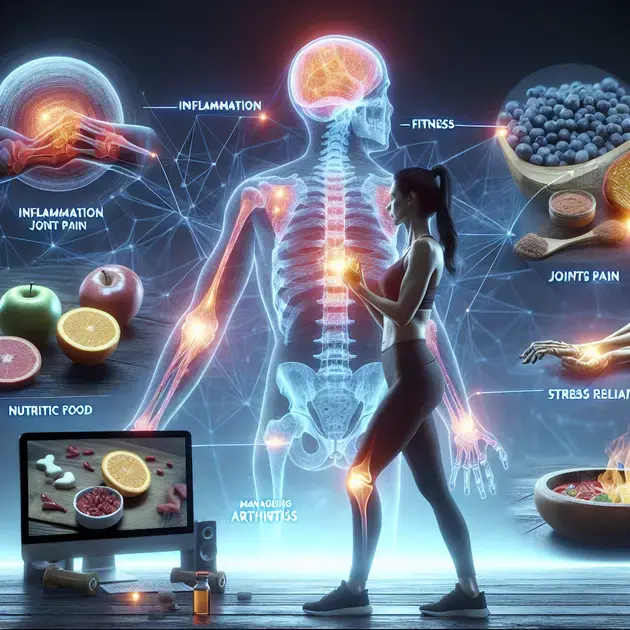Have you ever wondered what causes pain in the joints? Joint pain can be a common and debilitating issue that affects individuals of all ages. From arthritis to injuries, there are various factors that can contribute to joint pain.
Recent studies have shown that inflammation plays a crucial role in causing pain in the joints. When the body’s immune system responds to damaged tissues, it can lead to swelling and pain in the joints. Understanding the underlying causes of joint pain is essential for effective treatment and management strategies.

Understanding Inflammation and Joint Pain
When it comes to understanding inflammation and joint pain, it’s important to recognize that inflammation is the body’s natural response to injury or illness. In the case of joint pain, inflammation can occur due to conditions like arthritis, bursitis, or tendinitis. One effective way to manage inflammation and joint pain is through regular exercise. Apps like MyFitnessPal offer personalized workout plans and tracking tools to help individuals stay active and reduce inflammation.
In addition to exercise, maintaining a healthy diet can also play a crucial role in managing inflammation. Apps like MyPlate Calorie Counter provide guidance on nutritional intake and can help users make healthier food choices to reduce inflammation in the body. It’s important to focus on consuming anti-inflammatory foods such as fatty fish, berries, and leafy greens to support joint health.
Furthermore, staying hydrated is essential for combating inflammation and joint pain. Apps like WaterMinder can help track your daily water intake and remind you to stay hydrated throughout the day. Adequate hydration can help reduce inflammation and improve overall joint function.
Another key aspect of understanding inflammation and joint pain is stress management. High stress levels can exacerbate inflammation in the body, leading to increased joint pain. Mindfulness apps like Headspace offer guided meditation and relaxation techniques to help reduce stress and promote well-being, ultimately aiding in the management of joint pain.
Lastly, seeking professional medical advice and treatment is crucial for effectively managing inflammation and joint pain. Apps like Zocdoc can help individuals find and schedule appointments with rheumatologists or orthopedic specialists who can provide personalized treatment plans for joint pain and inflammation.
Arthritis and Joint Pain: The Connection
Understanding the connection between arthritis and joint pain is essential for effectively managing these conditions. Arthritis is a common cause of joint pain and is characterized by inflammation in the joints. One strategy for managing arthritis and joint pain is engaging in low-impact exercises. Fitness apps like FitOn offer arthritis-friendly workout routines that can help improve joint flexibility and reduce pain.
In addition to exercise, using heat or cold therapy can provide relief for arthritis-related joint pain. Apps like WebMD offer information on the proper application of heat packs or cold compresses to alleviate joint discomfort. Alternating between heat and cold treatments can help reduce inflammation and manage arthritis symptoms.
Dietary choices also play a significant role in the connection between arthritis and joint pain. Apps like Fooducate can assist individuals in making healthy food choices that can help reduce inflammation in the body. Incorporating anti-inflammatory foods such as turmeric, nuts, and tomatoes into your diet can support joint health and alleviate arthritis pain.
Furthermore, maintaining a healthy weight is crucial for managing arthritis and joint pain. Apps like Lose It! provide tools for tracking caloric intake and setting weight loss goals to achieve a healthy body mass index. Excess weight puts additional stress on the joints, exacerbating arthritis symptoms, so maintaining a healthy weight can help reduce joint pain.
Lastly, joining support groups or online communities can be beneficial for those dealing with arthritis and joint pain. Apps like Arthritis Foundation’s Live Yes! Online Community connect individuals facing similar challenges and provide a platform for sharing experiences and tips for managing arthritis symptoms effectively.

**Exploring Common Causes of Joint Pain**
Physical Inactivity
One of the most common causes of joint pain is physical inactivity. When we do not engage in regular exercise or movement, our joints can become stiff and weak. This lack of movement can lead to inflammation and pain in the joints, making it difficult to perform everyday tasks.
How to address Physical Inactivity:
To combat the effects of physical inactivity on joint health, it is essential to incorporate regular exercise into your routine. This can include activities such as walking, swimming, or yoga. By staying active, you can help keep your joints flexible and reduce the risk of pain and inflammation.
Poor Posture
Another common cause of joint pain is poor posture. When we sit or stand in positions that put excessive strain on our joints, it can lead to discomfort and pain over time. Poor posture can especially affect the joints in the back, neck, and knees.
How to address Poor Posture:
Improving your posture can help alleviate joint pain and prevent further discomfort. Focus on sitting and standing up straight, with your shoulders back and your spine aligned. Incorporating exercises to strengthen the muscles that support good posture can also be beneficial.
**Nutrition and Its Impact on Joint Health**
Processed Foods
The consumption of processed foods high in sugar, unhealthy fats, and additives can contribute to inflammation in the body, including the joints. A diet rich in processed foods can exacerbate joint pain and discomfort, making it important to be mindful of your food choices.
How to improve Nutrition:
To support joint health through nutrition, focus on a diet rich in whole foods such as fruits, vegetables, whole grains, and lean proteins. Incorporate anti-inflammatory foods like fatty fish, nuts, and seeds, while reducing your intake of processed and sugary foods.
Vitamin D Deficiency
Vitamin D plays a crucial role in bone health and joint function. A deficiency in this essential nutrient can lead to weakened bones and joint pain. It is important to ensure an adequate intake of vitamin D through sunlight exposure and dietary sources.
How to address Vitamin D Deficiency:
To prevent joint pain associated with vitamin D deficiency, consider incorporating foods like fatty fish, fortified dairy products, and egg yolks into your diet. Additionally, spending time outdoors in the sun can help your body produce vitamin D naturally.
**The Role of Exercise in Alleviating Joint Discomfort**
Low-Impact Exercises
Engaging in low-impact exercises can help alleviate joint discomfort by providing movement without putting excessive stress on the joints. Activities such as swimming, cycling, and yoga can improve flexibility, strength, and overall joint health.
How to incorporate low-Impact Exercises:
To benefit from low-impact exercises, start by gradually incorporating them into your fitness routine. Focus on movements that are gentle on the joints and emphasize form and alignment. Consistency is key to reaping the benefits of these exercises.
Strength Training
Strength training is essential for maintaining joint health and preventing discomfort. By strengthening the muscles that support the joints, you can improve stability and reduce the risk of injury. Incorporating exercises that target the muscles around the joints can alleviate pain and improve overall joint function.
How to include Strength Training:
To enhance joint health through strength training, incorporate exercises such as squats, lunges, and resistance band workouts into your routine. Start with lighter weights and gradually increase the intensity as your strength improves. Remember to listen to your body and seek guidance from a fitness professional if needed.
**
Conclusion
**
In conclusion, joint pain can stem from various factors such as physical inactivity, poor posture, nutrition, and vitamin D deficiency. Physical inactivity can lead to stiff and weak joints, causing inflammation and discomfort. By incorporating regular exercise like walking, swimming, or yoga, individuals can maintain joint flexibility and reduce the risk of pain.
Poor posture is another common culprit behind joint pain, especially in the back, neck, and knees. Improving posture by sitting and standing correctly and strengthening supportive muscles can help alleviate joint discomfort. Additionally, paying attention to nutrition is crucial, as processed foods high in sugar and unhealthy fats can contribute to inflammation. A diet rich in whole foods and anti-inflammatory choices like fatty fish and nuts can support joint health.
Furthermore, addressing vitamin D deficiency is essential for bone and joint function. Ensuring an adequate intake of vitamin D through diet and sunlight exposure can prevent weakened bones and associated joint pain. Engaging in low-impact exercises such as swimming, cycling, and yoga can alleviate joint discomfort by providing movement without excessive stress. Strength training is also key, as it helps strengthen supporting muscles, improve stability, and reduce the risk of injury.